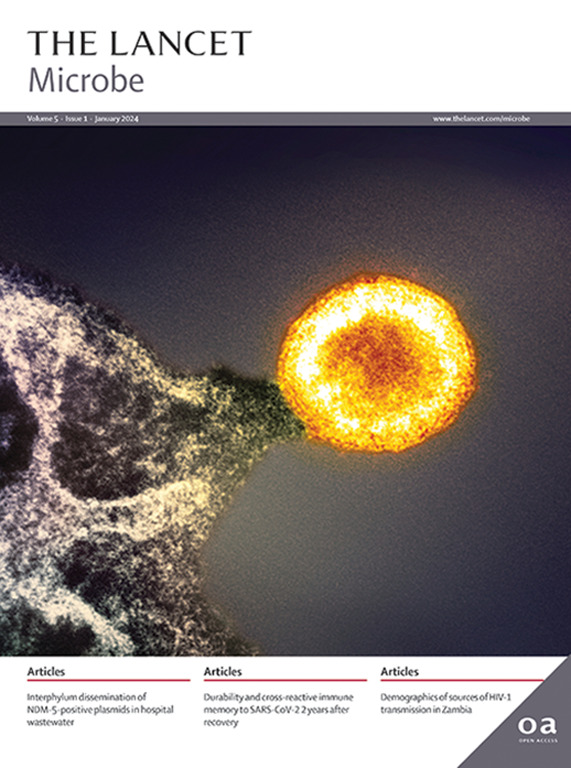选择候选淋病奈瑟菌用于口咽淋病人类挑战:基于基因组学的临床分离株分析。
IF 20.4
1区 生物学
Q1 INFECTIOUS DISEASES
引用次数: 0
摘要
背景:淋病奈瑟菌是一种具有重大公共卫生重要性的人类病原体,由于其全球流行率和抗菌素耐药性(AMR)不断增加。有证据表明,口咽感染在淋病奈瑟菌传播和抗菌素耐药性中起关键作用;然而,我们对口咽淋病的发病机制了解甚少。口咽淋病的控制人感染模型(CHIM)将提高对感染的认识,加快制定急需的淋病预防和治疗新策略。作为该CHIM开发的第一步,我们描述了一种利用基因组学和临床数据的CHIM菌株选择的系统方法。方法:在这项基于基因组学的分析中,我们对2017年1月1日至12月31日、2019年7月1日至2021年6月30日期间从澳大利亚维多利亚州成年患者中收集的淋病奈瑟菌临床分离株的主要数据集采用了系统的淋病奈瑟菌挑战菌株选择策略,结合基因组和临床数据。这种选择策略使用临床、表型和基因组特征来定义一套8个标准,旨在确保候选菌株的当代全球临床相关性;选择适用于评估当前和未来淋病疫苗的菌株;并通过降低播散性淋球菌感染和临床显著耐药性的风险,最大限度地提高参与者的安全性。我们将这些标准应用于我们的主要数据集,以生成潜在挑战菌株的面板。从这个潜在挑战菌株的最终数据集中,我们预先确定我们将选择多达10个分离株进行下一阶段的详细表型表征,以最终选择淋病奈瑟菌CHIM菌株。结果:主要数据集中有5881个分离株。应用筛选标准后,大多数分离株(5881株中的5795株[98.6%])被排除在外,主要是由于具有临床显著的AMR和较差的当代全球临床相关性。其余86株淋病奈瑟菌攻毒菌株候选株包括5种多位点序列型和6种淋病奈瑟菌多抗原序列型,其中许多由单一分离株代表。在这86株菌株中,选择了5株菌株,以最大限度地覆盖86株候选挑战菌株中系统发育上不同的群,并确保从不同解剖部位收集的菌株的代表性。解释:我们透明地描述了一种新的、系统的、合理的基于基因组学的口咽淋病CHIM菌株选择策略,该策略提高了CHIM菌株选择的效率和透明度,并能够识别当代和临床相关的潜在挑战菌株。经过详细的表型评估,将从五个入围候选菌株的子集中选择最终的淋病奈瑟菌挑战菌株。资助:医学研究未来基金、澳大利亚国家卫生和医学研究理事会和澳大利亚政府研究培训计划。本文章由计算机程序翻译,如有差异,请以英文原文为准。
Selecting candidate Neisseria gonorrhoeae strains for oropharyngeal gonorrhoea human challenge: a genomics-based analysis of clinical isolates
Background
Neisseria gonorrhoeae is a human pathogen of major public health importance due to its increasing global prevalence and antimicrobial resistance (AMR). Evidence suggests that oropharyngeal infection plays a key role in N gonorrhoeae transmission and AMR; however, our understanding of oropharyngeal gonorrhoea pathogenesis is poor. A controlled human infection model (CHIM) for oropharyngeal gonorrhoea will improve understanding of infection and accelerate urgently needed novel gonorrhoea prevention and therapeutic strategies. As the first step in the development of this CHIM, we describe a systematic approach to CHIM strain selection that leverages genomics and clinical data.
Methods
In this genomics-based analysis, we applied a systematic N gonorrhoeae challenge strain selection strategy incorporating genomic and clinical data to a primary dataset of clinical isolates of N gonorrhoeae collected from adult patients in Victoria, Australia, between Jan 1 and Dec 31, 2017, and July 1, 2019, and June 30, 2021. This selection strategy used clinical, phenotypic, and genomic characteristics to define a set of eight criteria that aimed to ensure the contemporary global clinical relevance of the candidate strains; select strains that would be applicable for the assessment of current and future gonorrhoea vaccines; and maximise participant safety by reducing the risk of disseminated gonococcal infection and clinically significant AMR. We applied these criteria to our primary dataset to generate a panel of potential challenge strains. From this final dataset of potential challenge strains, we predetermined that we would select up to ten isolates to proceed to the next stage of detailed phenotypic characterisation for final N gonorrhoeae CHIM strain selection.
Findings
5881 isolates comprised the primary dataset. After application of the selection criteria, most of the isolates (5795 [98·6%] of 5881) were excluded, mostly due to having clinically significant AMR and poor contemporary global clinical relevance. The remaining 86 N gonorrhoeae challenge strain candidates comprised five multilocus sequence types and six N gonorrhoeae multiantigen sequence types, many of which were represented by a single isolate. Of these 86 strains, five isolates were selected to maximise coverage of the phylogenetically distinct groups within the 86 candidate challenge strains and ensure representation of strains collected from various anatomical sites.
Interpretation
We transparently describe a novel, systematic, and rational genomics-based strategy for oropharyngeal gonorrhoea CHIM strain selection that improves the efficiency and transparency of CHIM strain selection and enables identification of contemporary and clinically relevant potential challenge strains. A final N gonorrhoeae challenge strain will be selected from the subset of five shortlisted candidates after detailed phenotypic assessment.
Funding
Medical Research Future Fund, Australian National Health and Medical Research Council and Australian Government Research Training Program.
求助全文
通过发布文献求助,成功后即可免费获取论文全文。
去求助
来源期刊

Lancet Microbe
Multiple-
CiteScore
27.20
自引率
0.80%
发文量
278
审稿时长
6 weeks
期刊介绍:
The Lancet Microbe is a gold open access journal committed to publishing content relevant to clinical microbiologists worldwide, with a focus on studies that advance clinical understanding, challenge the status quo, and advocate change in health policy.
 求助内容:
求助内容: 应助结果提醒方式:
应助结果提醒方式:


